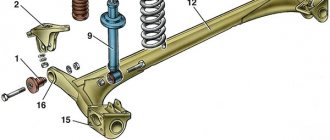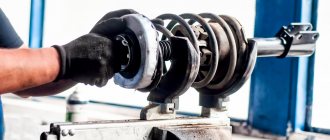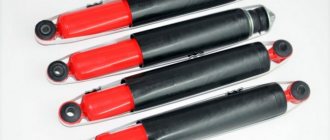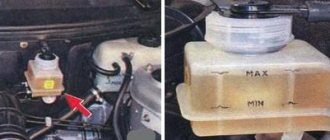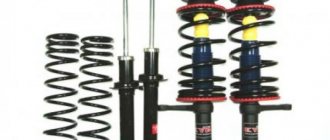Every owner of a vehicle, regardless of its make and size, is certainly aware of the significant role shock absorbers will play in the design of the car. Their main tasks are to dampen suspension vibration, increase vehicle handling control, and improve wheel contact with the road surface. Shock absorbers, just like any other elements of a car, require careful and attentive treatment, systematic maintenance, careful selection, and correct installation. More on this later in the article.
Shock absorbers, what they are needed for and where they are installed
When accelerating, the vehicle “squats” backward, unloading the front wheels and loading the rear wheels, which reduces their grip on the road surface. When braking, the opposite is true. In both the first and second cases, the ideal position would be one in which the machine would maintain its normal “horizontal” position.
Approximately the same picture is observed during maneuvering, however, the load here shifts along the sides of the car, and not along the axes.
Shock absorbers keep the wheels in constant contact with the road surface to prevent the driver from losing control of the vehicle. The racks are installed directly next to the car wheels.
Is it worth pumping and restoring shock absorbers?
During the next major overhaul of the chassis, the car owner often has to deal with a proposal from the craftsmen to resort to pumping, i.e., restoration of shock absorbers, instead of simply buying a new unit. The motivation for such a proposal is more than simple: why spend extra money if you can save a lot by restoring a suspension part that has become unusable. As a rule, many agree to such an offer, feeling the temptation to save part of the financial resources. At this time, some drivers will seriously think about the feasibility of this prospect, while others simply go to the store and buy new shock absorbers from a trusted manufacturer. But which of these three drivers is more right and is it even worth restoring the old shock absorber? How will the restoration of the damping elements of the suspension affect the driving performance of the car? In order to answer these questions, we should first recall the evolution of the global automotive industry, namely, in the development of new, more advanced shock absorbers. Undoubtedly, to this day, one of the most important breakthroughs is the creation of a two-pipe shock absorber with gas pressure, popularly called a gas-oil shock absorber. The main feature of this design is that the use of gas pressure can significantly unload the springs during the rebound stroke, but at the same time the working fluid does not allow the shock absorber to “shoot” too quickly.
Although the gas pressure shock absorber works in two directions, when it is decompressed, it also helps the spring return to its original position. In addition, an important function of gas is its ability to withstand shock when driving at high speed on poor-quality road surfaces, which prevents the phenomenon of punctures in the body. You can imagine a similar situation if you remember driving a classic “Zhiguli”, when when hitting a small bump the driver winces as if the impact was not on the body, but on its fifth fulcrum.
There is a common misconception among inexperienced drivers that gas shock absorbers “stink” at low temperatures. It is necessary to immediately make a reservation that this myth is a figment of the imagination of those people who do not understand the basic physical and chemical properties of materials even at the school level. After all, nitrogen, which is most often used in shock absorbers, simply loses its pressure in cold weather, and the shock absorber briefly acquires the characteristics of an oil shock absorber. This causes suspension breakdowns, but until the shock absorber warms up.
Based on everything stated above, the conclusion suggests itself that gas-oil shock absorbers are better and more comfortable for any car. If we talk about whether it is worth pumping the shock absorber and trying in every possible way to restore its performance, then the answer is clear - under no circumstances. Why so categorical? Yes, all for the reason that no master can restore the nitrogen that has escaped from the shock absorber, and even with exactly the same pressure as provided by the manufacturer. As a result, in the best case, the shock absorber will have the characteristics of an oil shock absorber, as a result of which frequent breakdowns will quickly damage the suspension and lead to a new overhaul. However, it is up to each driver to decide for himself whether to revive the shock absorber or not, but the old truth says: “the miser pays twice.”
By the way, initially the definition of “bleeding” meant disassembling the shock absorber, replacing its working fluid, gaskets, seals and reassembling it.
Which oil shock absorbers are better?
- KONI are the most expensive shock absorbers, but also the most durable. These racks are the development of the Dutch company of the same name. They are used on virtually all types of transport. They are distinguished by the ability to adjust characteristics.
- Bilstein is a symbol of reliability and quality. They are quite common. Installed on the following car brands: Ferrari, Jaguar, Lamborghini.
- Boge - produced by a well-known company from Germany. Supplied for installation on cars of the following concerns: Volkswagen, Audi, BMW, Alfa Romeo, Volvo. They are affordable and do not actually change the suspension characteristics of modern foreign cars.
- Monroe is one of the best American companies. Its products are installed on new vehicles in America and throughout Europe. One of the best developments is the Reflex series shock absorbers, which are able to provide maximum contact with the road surface.
- Tokiko is one of the largest stand manufacturers in Japan. The reasons for the popularity of these products are low price, high quality and long service life. However, when purchasing these products, beware of Chinese counterfeits.
- Sachs - these products are manufactured by a German company. As it should be, all products are reliable and high quality.
- Kayaba, a Japanese company that manufactures these products, appeared on the market in 2000 and almost immediately gained wide popularity. The company's main advantages are good quality, a wide range of products and low cost. Kayaba supplies its products to Mazda, Toyota and Honda.
Why is pumping done?
Not everyone understands why pumping is done and whether it is necessary at all. Some clarity should be provided on this score in order to finally understand the meaning of pumping and the urgent need for such a procedure.
Towbar for Kia Rio: which one to buy and how to install it yourself
Category: Towbars
The working mechanisms of shock absorbers include special sleeves in their design. If air gets inside them, then the device will not be able to return to its original position. Moreover, before installation, air must be removed from new and old parts if you suddenly bought used shock absorbers because their price turned out to be lower. It cannot be ruled out that during the suspension repair process or during troubleshooting, air penetrated inside the mechanism.
We recommend: The best way to flush the engine before changing the oil
During storage and transportation, the oil included in the shock absorber penetrates the outer cylinder of the structure, which is why the gas ends up inside the system. This phenomenon leads to the fact that after installing even a new part, a knock is heard.
By performing special actions, excess air is removed from the cylinder. This is done immediately before installation.
And it is still relevant to ask why this is being done. Everything is extremely simple. To ensure correct, efficient and long-term operation of new shock absorbers installed as part of a dependent or independent suspension.
Bleeding the shock absorber, why you need to bleed the shock absorber before installation
Oil shock absorbers are pumped to bring them into working condition:
- To prevent oil or air (pressure gas) from remaining in the inner sleeve of the strut, which can lead to shock absorber failure.
- To diagnose possible jamming of the strut valve mechanism or other malfunctions.
If a conventional twin-tube shock absorber is not bled before installation on a vehicle, its piston group may fail. In addition, in this case, the warranty does not apply to the product, that is, it is simply “money down the drain.”
It is important to know that insignificant dips in the resistance of the valve mechanism may be observed, which is not considered a malfunction, since this does not in any way affect the overall performance of the device.
Varieties
If a car enthusiast knows what shock absorbers he knows, then we will get something like this: oil, gas-oil and gas. This answer is partially correct. It is more correct to divide into two types: oil and gas.
This division is based on the use of different working substances. Gas shock absorbers use an inert gas, most often nitrogen, pumped under high pressure. In oil shock absorber struts, hydraulic oil and air or gas are pumped into the working space.
Structurally, they are divided into two types: two-pipe and single-pipe.
The first type of shock-absorbing struts is the most common due to its simplicity and low cost of manufacture. Oil or gas and oil are used as the working substance. The main disadvantage of oil shock absorbers is poor cooling of the working substance. The oil gets very hot due to its small working volume. High temperatures cause the oil to foam and the shock absorber stops working correctly.
Shock absorbers are structurally made into two-pipe and single-pipe. Oil and gas are pumped into the middle
Gas-oil shock absorber struts are partially free of this drawback. Oil and air are pumped into a two-pipe housing under a pressure of 2–3 atmospheres. Sometimes nitrogen is used instead of air. This solution reduces the likelihood of aeration - foaming of the oil.
This is interesting: They decided to simplify the requirements for trucks and buses imported into Russia
Structurally, monotube shock absorbers do not have a working chamber. It is replaced by the rack housing. The tube is divided into two sections. The upper part is filled with oil, and the lower part is filled with high pressure gas. There is a valve between the sections.
Gas shock absorbers are of particular interest to drivers. This is no accident. Gas struts are primarily used in motorsports. For sports driving, this type of rack is most often chosen. The operation of the gas shock absorber is ensured by pumped gas under high pressure. Such racks are the toughest and driving on city roads is accompanied by shocks and impacts. Such a ride cannot be called comfortable, but driving will be clear and controlled. Therefore, gas shock absorber struts are used mainly on racing cars.
A special type of shock absorbers are the so-called “reversals”. They were given this name not because they can be placed upside down. In such racks, the reverse position of the rod is used. In conventional shock absorbers, the rod is directed upward. In inversions, the rod is directed downwards and is attached to the shock-absorbing strut body. There is a pseudo-rod on top. It looks much thicker. The operation of the inverted shock absorber is ensured by several plain bearings. This design reduces the vertical and lateral load on the rack.
Bleeding the shock absorber, general bleeding rules
- Shock absorbers are pumped vertically (with the rod up).
- After bleeding the strut, it should be held in an upright position with the rod up until it is installed on the vehicle.
- Some shock absorber designs include an oil drain system. Methods: either using a technological groove, which is located at the top of the rod, or by dropping the rod into the rack. In the latter case, the rack rod should be left uncompressed by 2-3 centimeters. In the first case, the rod is compressed to the technological groove that is located on it.
How to work with gas oil
Help: The spelling “gas-oil” is erroneous. That’s right: “gas-oil.”
Gas-oil shock absorbers must also be pumped before installation, whether new or used.
- The stand must be turned into a vertical position with the cylinder facing up.
- It is necessary to compress the shock absorber and hold it in this position for several seconds.
Hold the shock absorber in the lowered position for several seconds - Next, the shock absorber turns over, but must be in a compressed position.
- The cylinder is pulled out very slowly to its original position.
Smoothly pull the cylinder up - The procedure should be performed 3-4 times at short time intervals - no more than a few seconds.
After bleeding, do not turn the shock absorber over, otherwise you will need to perform the procedure again. If you hear a slight slurping sound when you press the body, don’t worry. This is not a malfunction.
How to pump such shock absorbers (video)
If all actions are performed correctly, there should be no knocks or other extraneous sounds. Otherwise, the procedure should be repeated. If you cannot bleed the shock absorber yourself, you should contact a specialized service. There are many devices, stands, attachments and other special equipment for high-quality performance of the procedure.
Bleeding oil shock absorbers, how to properly bleed oil shock absorbers
MacPherson shock absorbers are standard on modern cars.
Therefore, we will consider the technology of pumping racks using their example:
- We turn the shock absorber over with the rod down and compress it smoothly, without jerking.
- We fix the shock absorber in this position for three seconds.
- We turn the shock absorber upside down, holding the rod, and fix it for six seconds in this position.
- Next, smoothly extend the rod to the end of the stroke.
- We turn the rack over again with the rod down, take a short pause (three seconds) and repeat the procedure. The number of approaches is from 1 to 6.
In the third approach, perform a control action - the shock absorber is positioned vertically, with the rod up, using short sharp movements to make sure that the rod moves smoothly. The piston should also move smoothly, without dips.
Pumpable types of shock absorbers
Surely you know that shock absorbers are divided into oil, gas and gas-oil. All of them are quite actively used in the design of vehicles.
In this case, pumping is required for all categories of suspension units:
- front shock absorbers;
- rear;
- new parts;
- used;
- original;
- analog;
- single-pipe;
- two-pipe;
- collapsible;
- non-separable.
As you can see, it doesn’t matter what kind of shock absorbers we are talking about. All of them are subject to preliminary pumping before installation. Let you have at your disposal an ordinary old Gazelle or a brand new Audi. Although owners of expensive cars often prefer to have their car serviced at a car service center. But that’s not about that now.
Although it is not fundamentally important whether the shock absorbers are rear and new, or front and used, special attention should be paid to the specific type of element. Gas, oil and gas-oil shock absorbers have their own instructions. Relying on them, you can pump the part with your own hands, and the rack will work for a long time, efficiently and effectively.
Gas shock absorbers
Let's start with pumping these particular shock absorbers. The gas most often used here is nitrogen. It's not difficult to upgrade them. You just need to follow a certain sequence of actions:
- Turn the assembly over so that the rod is pointing down toward the floor;
- Now slowly begin to compress the shock absorber;
- After squeezing, hold it in this position for a few seconds;
- Then turn the part the other way around;
- Hold the rod clamped for 4-5 seconds;
- Pull the rod back until it stops;
- Turn the shock absorber over;
- Leave the element in a horizontal position and install it on the car.
At this point, pumping is considered complete. Like I said, nothing complicated. Take your time, but also try not to keep gas-type shock absorbers in a compressed state for more than 6 seconds.
Oil shock absorbers
In the case of such car shock absorbers, the procedure is somewhat different. It is extremely important to strictly follow the given algorithm. The more accurately you follow the instructions, the higher the likelihood of doing everything as correctly as possible.
- Place the shock with the rod down, as in the case of gas elements;
- Smoothly compress the shock absorber until it stops;
- Having completed the compression, do not release the part and hold for 2-3 seconds;
- Without releasing the rod, turn the shock absorber over;
- Hold in a compressed state for up to 6 seconds;
- At this time, the air should come out;
- Then pull the rod out all the way;
- Turn the shock upside down;
- Wait about 3 seconds, and perform similar manipulations at least 3 times.
How to bleed oil and gas-oil shock absorbers
Experienced drivers know how important it is to bleed the shock absorber before installing it.
And it doesn’t matter whether it is oil or gas-oil (gas), from Kayaba or another manufacturer, for a VAZ 2107 or Mitsubishi OUTLANDER XL, if you do not pump the shock absorber strut (another name for the device) in a timely manner, this will negatively affect its performance and service life.
This will also allow you to timely identify a defective product and replace it under warranty.
And also, if the car has not been used for more than a year, it is also recommended to bleed its shock absorbers, regardless of their type, since long-term parking adversely affects the optimal condition of the working compounds (oil, air, nitrogen).
Next we will tell you how to properly bleed oil, gas-oil (gas) shock absorbers before installing them.

